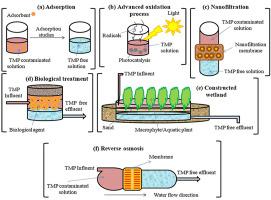Journal of Cleaner Production ( IF 11.1 ) Pub Date : 2021-05-04 , DOI: 10.1016/j.jclepro.2021.127359 Farid Mzee Mpatani , Aaron Albert Aryee , Alexander Nti Kani , Runping Han , Zhaohui Li , Evans Dovi , Lingbo Qu

|
Antibiotics are among the emerging pollutants that pose hazardous effects to the aquatic environment and human health if not properly controlled. Trimethoprim (TMP) is one of the most regularly administered antibiotics whereby its existence in aquatic surroundings has received much concern in recent decades due to its persistent behaviors. In this review, different treatment techniques that have been applied for selective removal of trimethoprim from aqueous systems were discussed in detail. Several studies have reported on the incidence of TMP in water systems including wastewaters, groundwater, river water, surface water and drinking water. The findings from the literature have shown that the advanced oxidation processes (AOPs) have been comprehensively applied for the elimination of trimethoprim from water systems as compared to other treatment techniques. AOPs (particularly ozonation) have showed noteworthy performances on removing TMP followed by membrane processes (nanofiltration and reverse osmosis), combined processes and adsorption process. Effectuation of oxidation processes could be explained due to the structural nature of TMP which contains moieties such as electron-rich aromatic system and deprotonated amine that are highly prone to oxidation attack. However, most of oxidation methods have several limitations that hinder their worldwide applications. A number of oxidation and transformation products are usually formed after treatment of TMP; some of the products are reported to be resistant to further oxidation. Therefore, these products should be carefully examined, and toxicity assessment should be further performed to know the possible toxic effects of transformation and oxidation products, as currently there are limited data available. Lastly, although the adsorption process had been associated with several advantages on removing antibiotics, only limited studies have so far been reported on the removal of TMP via adsorption. Thus, there is a niche for wide range of adsorbents to be investigated for their efficiency for the uptake of TMP from aqueous systems. Therefore, future studies should also focus on synthesizing various adsorbents such as biochars, nanoparticles (carbon nanodots, carbon nanotubes, etc), microporous carbonaceous and polymers that are derived from low-cost agricultural waste materials and examine their adsorption performances toward trimethoprim.
中文翻译:

从水系统中选择性去除新兴污染物甲氧苄啶的处理技术综述
抗生素是新兴的污染物之一,如果控制不当,会对水生环境和人类健康造成危害。甲氧苄氨嘧啶(TMP)是使用最频繁的抗生素之一,由于其持久的行为,近十年来它在水生环境中的存在备受关注。在这篇综述中,详细讨论了用于从水性系统中选择性去除甲氧苄啶的不同处理技术。一些研究报告了TMP在水系统中的发生率,包括废水,地下水,河水,地表水和饮用水。文献中的发现表明,与其他处理技术相比,高级氧化工艺(AOP)已被广泛应用于从水系统中消除甲氧苄啶。AOP(特别是臭氧化)在去除TMP,随后的膜工艺(纳米过滤和反渗透),组合工艺和吸附工艺方面表现出显着的性能。可以解释由于TMP的结构性质而导致的氧化过程的完成,TMP的结构部分例如富含电子的芳族系统和去质子化的胺极易发生氧化攻击。但是,大多数氧化方法都有一些局限性,阻碍了其在世界范围内的应用。在TMP处理后,通常会形成许多氧化和转化产物。据报道,某些产品具有抗进一步氧化的能力。因此,由于目前可用的数据有限,应仔细检查这些产品,并应进一步进行毒性评估,以了解转化和氧化产品可能产生的毒性作用。最后,尽管吸附过程在去除抗生素方面具有多种优势,但到目前为止,关于通过吸附去除TMP的报道很少。因此,对于吸附剂从水性体系中吸收TMP的效率进行研究的范围很广,这是一个利基市场。因此,未来的研究还应侧重于合成各种吸附剂,例如生物炭,纳米颗粒(碳纳米点,碳纳米管等),



























 京公网安备 11010802027423号
京公网安备 11010802027423号